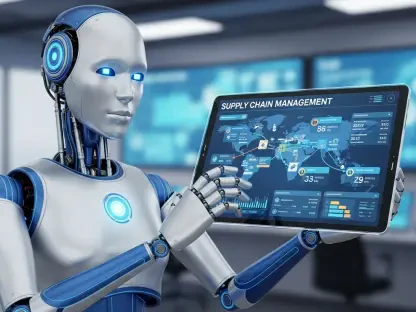In the fast-paced world of global trade, where over 90% of goods traverse vast distances by sea, air, land, and rail, the logistics industry stands as the backbone of commerce, yet faces mounting pressure to meet skyrocketing consumer expectations for speed and transparency. A single delayed shipment can ripple through supply chains, costing companies millions and eroding customer trust in an era where same-day delivery is becoming the norm. This critical juncture has spurred a technological revolution, with Artificial Intelligence (AI) emerging as a game-changer, promising not just to streamline operations but to redefine how customers interact with logistics services. This report delves into the profound impact of AI on customer experience, exploring its applications, challenges, and future potential within this vital sector.
Understanding the Logistics Industry and AI’s Role
The logistics sector operates as a complex network, facilitating the movement of goods across continents through diverse modes of transport, including shipping, aviation, trucking, and rail systems. Encompassing key segments like freight management, warehousing, and last-mile delivery, the industry is driven by major players such as Walmart, Amazon, DHL, and Maersk, who collectively handle billions of transactions daily. Their operations underpin global economies, ensuring that products reach markets and consumers with precision, despite challenges like geopolitical disruptions and fluctuating demand.
Technology, particularly AI, has become a pivotal force in transforming logistics from a reactive model—where issues are addressed after they arise—to a proactive framework that anticipates and mitigates problems. AI tools enable real-time decision-making, optimizing everything from shipment routes to inventory levels, thus reducing delays and costs. This shift is not merely operational; it directly enhances the customer journey by providing predictability and reliability in delivery timelines.
Customer experience (CX) has emerged as a critical differentiator in this competitive landscape, as consumers increasingly demand faster, more transparent services. With e-commerce giants setting high benchmarks for delivery speed, logistics providers must leverage AI to meet these expectations, turning operational efficiency into a customer-facing advantage. The focus on CX reflects a broader trend where satisfaction and trust are as valuable as the goods being transported.
Current Trends and Market Dynamics of AI in Logistics
Emerging Technologies and Consumer Expectations
AI adoption in logistics is propelled by cutting-edge technologies such as predictive analytics, automation, and real-time visibility platforms, which collectively address inefficiencies across supply chains. Predictive analytics forecasts demand and potential disruptions, while automation streamlines repetitive tasks like sorting and packing in warehouses. Real-time tracking tools provide updates on shipment status, ensuring stakeholders remain informed at every stage.
Consumer behavior has also evolved, with expectations leaning toward rapid deliveries, full visibility into shipment progress, and environmentally conscious practices. The surge in e-commerce, fueled by global online shopping trends, has intensified these demands, creating bottlenecks in last-mile delivery and inventory management. AI offers solutions by identifying optimal delivery routes and reducing idle times, directly addressing pain points that frustrate customers.
Notable applications include UPS’s ORION system, which optimizes driver routes to save millions of miles annually, and Amazon’s robotic warehouse systems that enhance picking accuracy. These innovations not only cut operational costs but also ensure quicker, more reliable deliveries, aligning with consumer desires for efficiency. As these technologies scale, they set new standards for what customers expect from logistics services.
Market Growth and Future Projections
Investment in AI for logistics has surged, with market size estimates projecting significant expansion over the coming years due to increased adoption by major firms. Data indicates that companies implementing AI have seen tangible benefits, such as Amazon’s reported 40% faster fulfillment times and improved on-time delivery rates across various regions. These metrics highlight AI’s capacity to transform operational performance into measurable customer benefits.
Forecasts suggest that AI will continue to drive efficiency, with potential cost savings and productivity gains becoming more pronounced as systems mature. From 2025 to 2027, industry analysts anticipate a steep rise in AI integration, particularly in automation and analytics, which could further reduce delivery windows and enhance service reliability. These projections are grounded in current case studies demonstrating scalable results among leading logistics providers.
Globally, AI implementation varies by region, with the U.S. focusing on last-mile innovations, Europe prioritizing port and maritime optimization, the Middle East advancing smart infrastructure, and Asia leading in warehouse automation. This diversity reflects unique regional challenges and opportunities, yet underscores a universal push toward leveraging AI for competitive advantage. As adoption grows, the global logistics landscape is poised for a more interconnected, intelligent future.
Challenges in Adopting AI for Logistics Customer Experience
Implementing AI in logistics is not without hurdles, as high initial costs for data harmonization and infrastructure upgrades pose significant barriers for many companies. Establishing unified data systems to feed AI algorithms requires substantial investment, often straining budgets, especially for smaller players in the market. This financial burden can delay or limit the scope of AI initiatives, impacting their potential reach.
Technological challenges further complicate adoption, with fragmented data systems across legacy platforms hindering seamless integration. Cybersecurity risks also loom large, as increased reliance on digital tools exposes sensitive shipment and customer information to potential breaches. Addressing these issues demands robust security protocols and continuous system updates, adding layers of complexity to AI deployment.
Human factors play a critical role as well, with cultural resistance to relying on algorithms over traditional judgment slowing progress in some organizations. Workforce retraining is essential to bridge skill gaps, ensuring employees can effectively interact with AI tools. Solutions such as partnerships, exemplified by Maersk’s collaboration with IBM Watson, alongside pilot testing and phased rollouts, offer pathways to mitigate these challenges, fostering gradual acceptance and refinement of AI systems.
Regulatory and Compliance Landscape for AI in Logistics
The adoption of AI in logistics operates within a complex regulatory framework, where data privacy laws and cybersecurity standards dictate how technologies can be deployed. Regulations such as the General Data Protection Regulation in Europe impose strict guidelines on handling customer and operational data, requiring companies to balance innovation with compliance. These rules shape the design and functionality of AI systems to protect user information.
Compliance requirements extend to real-time tracking and automated systems, varying significantly across regions due to differing legal priorities. For instance, standards for cross-border data sharing and system interoperability must be navigated carefully to avoid penalties or operational disruptions. Logistics firms must stay agile, adapting AI tools to meet these diverse mandates while maintaining service quality.
Sustainability regulations also influence AI applications, pushing for optimizations that reduce emissions through efficient routing and port management. Policies targeting lower carbon footprints encourage the use of AI to minimize fuel consumption, aligning with broader environmental goals. Striking a balance between regulatory adherence and technological advancement remains a key consideration, ensuring that innovation does not outpace ethical or legal boundaries.
Future Outlook: AI’s Evolving Impact on Logistics CX
Looking ahead, AI’s trajectory in logistics points to groundbreaking developments, with emerging technologies like autonomous vehicles and advanced machine learning poised to redefine operational capabilities. Self-driving delivery vans and drones could revolutionize last-mile services, cutting costs and enhancing speed in urban environments. Meanwhile, sophisticated algorithms will likely offer deeper insights into supply chain dynamics, further refining efficiency.
Potential disruptors, including smaller firms leveraging AI for niche markets, may challenge established players by offering specialized, customer-focused solutions. Additionally, new sustainability mandates could accelerate AI-driven innovations aimed at reducing environmental impact, such as optimized freight consolidation. These shifts suggest a landscape where agility and adaptability become paramount for maintaining market relevance.
Consumer preferences are also evolving, with a growing emphasis on eco-friendly practices and high transparency in logistics services. This trend will likely drive demand for AI systems that provide detailed shipment tracking and minimize carbon footprints. Growth areas such as last-mile innovations and global supply chain resilience will remain focal points, influenced by economic fluctuations and technological advancements, shaping a future where customer needs dictate industry priorities.
Conclusion
Reflecting on the insights gathered, it becomes evident that AI has already begun to reshape customer experience in logistics through unprecedented efficiency, transparency, and reliability. The journey of industry giants like Walmart and DHL illustrates how strategic investments in AI yield faster deliveries and foster greater trust among consumers. Challenges such as high costs and regulatory complexities are navigated with innovative partnerships and phased approaches, setting a precedent for others to follow.
Moving forward, companies should prioritize building robust data infrastructure to support scalable AI solutions, ensuring seamless integration across operations. Forming strategic alliances with technology providers could accelerate adoption while mitigating risks. Investing in talent development to upskill the workforce is also critical, as human expertise remains essential alongside automation. These actionable steps promise to position logistics firms at the forefront of a customer-centric era, where AI solidifies its role as an indispensable driver of competitive advantage.









